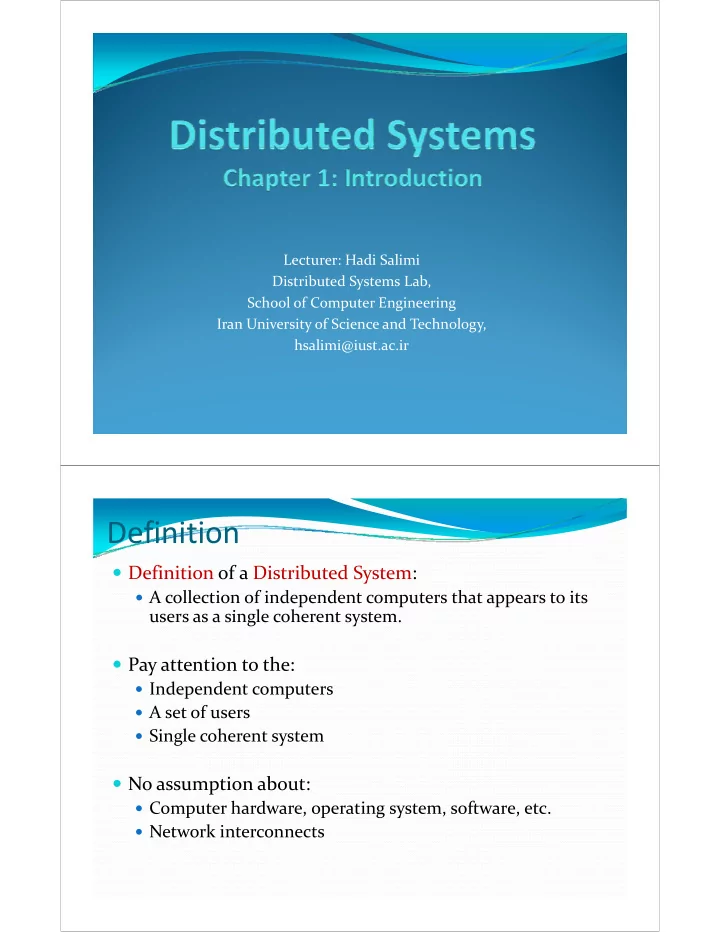

Lecturer: Hadi Salimi Lecturer: Hadi Salimi Distributed Systems Lab, School of Computer Engineering I Iran University of Science and Technology, U i i f S i d T h l hsalimi@iust.ac.ir Definition � Definition of a Distributed System: � A collection of independent computers that appears to its users as a single coherent system. i l h t t � Pay attention to the: Pay attention to the: � Independent computers � A set of users � Single coherent system � No assumption about: � No assumption about: � Computer hardware, operating system, software, etc. � Network interconnects
Components Components of a distributed system Distributed Systems Goals � Four different goals that should be met to make building the distributed system worth of effort: � Making resources available to users � Hide the fact that resources are distributed (Transparency) � It should be open � It should be scalable � It should be scalable
Transparency Different types of transparency in a distributed system Transparency vs. Performance � There are cases in which hiding all aspects of a distributed system is not a good idea: � Requesting to have your daily newspaper in your mailbox � Multiple tries of a client to re ‐ connect a server in transient failure cases � Making several replicas consistent � Making several replicas consistent � Hiding the distribution of a system in pervasive environment may not be a good idea always
Openness � An open distributed system is a system that offers services according to standard rules that describe the syntax and semantics of those services. � Some services at a distributed system expose interfaces to S i di ib d i f the world. � Interfaces could be defined using Interface Definition Interfaces could be defined using Interface Definition Language (IDL) � What does an IDL describe? Syntax or semantics? Policy and Mechanism � There should be a clear border between the definition of a service and its implementation. � These two parts are called the policy and mechanism � As an example, consider the case of web caching policy and different parameters for its implementation. d diff f i i l i
Scalability � Scalability of a system can be measured at least three different dimensions: � Size scalability � Geographical scalability � Administrative scalability Scalability Problems Scalability Problems
Scaling Techniques � There are three main techniques for making the systems scalable: � Hiding communication latencies � Distribution � Replication Scaling Techniques (Cont.) (a) Checking the form in the server side (b) checking the form in ( ) g ( ) g the client side
Scaling Techniques (Cont.) Distribution technique for making the systems scalable Distribution technique for making the systems scalable Pitfalls � False assumptions made by first time developer: • The network is reliable. • The network is secure. • The network is homogeneous. • The topology does not change. • Latency is zero. • Bandwidth is infinite. B d idth i i fi it • Transport cost is zero. • There is one administrator There is one administrator.
Distributed System Types � Types of Distributed System: � Distributed Computing Systems � Distributed Information Systems � Enterprise Application Integration (EAI) � Distributed Pervasive Systems Di ib d P i S Cluster Computer Systems Cluster computer systems (Linux ‐ based Beowulf)
Grid Computing � Grid are different from clusters in: � Gris are highly heterogeneous � Grid are distributed geographically � Grids are based on the concept of Virtual Organizations and sharing them among different users. Pervasive Systems � Pervasive systems are characterized by: � The environment is not stable � Devices are small and power matters � Lack of human administration � Networks are performed add ‐ hoc � Examples include: E l i l d � Sensor networks � Electronic Health ‐ case systems � Electronic Health ‐ case systems � Home systems
Spectrum of HW � MPP (Massively Parallel Processors) ‐ Multiprocessor � Expensive, need HP networking, simultaneous access to shared memory, single address space, hardwired, tightly couples � COW (Cluster of Workstations) – Multi ‐ computer COW (Cluster of Workstations) Multi computer � Cheaper, easy to make, message passing, not hardwired, flexible, loosely coupled Distributed Shared Memory (DSM) a) Pages of address space distributed among four machines machines b) Situation after CPU 1 references page 10 Si Situation if page 10 i if c) ) is read only and replication is used p
Network and Distributed OSs � Distributed Operating System DOS HW HW � Network Operating System Network Operating System NOS NOS HW HW
Recommend
More recommend